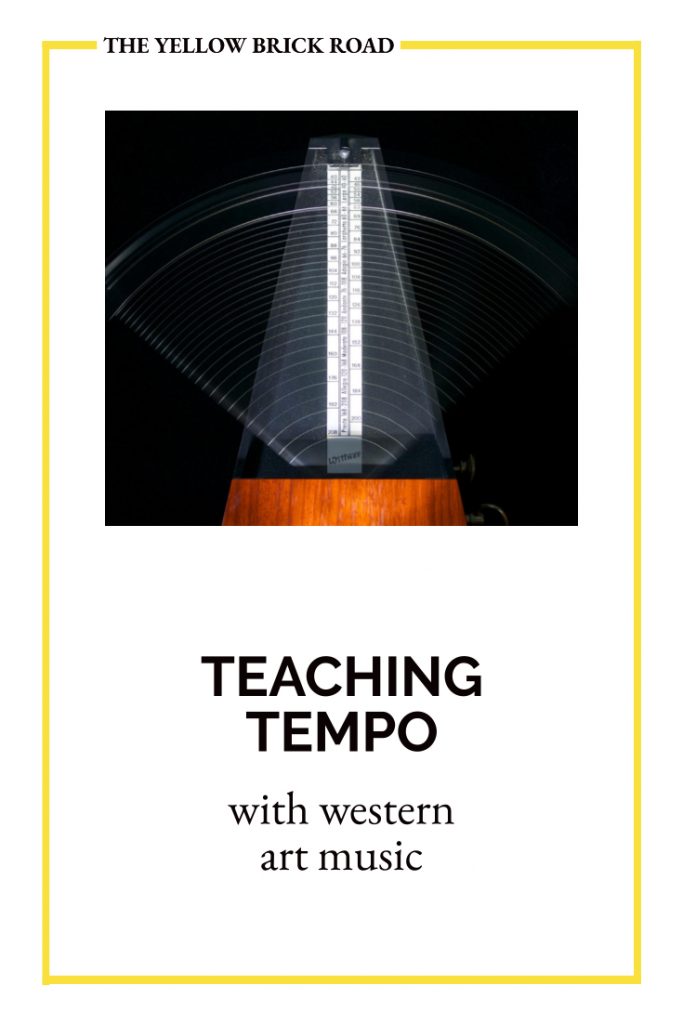It can seem overwhelming to incorporate western art music into the elementary music classroom. The attention span of students is equal to that of a goldfish or me when I’m attempting to do math. The 27-minute symphony that makes you break down into happy tears every time you hear it probably won’t work with your elementary students. So, how do you incorporate this genre seamlessly as you do with so many other genres in your classroom? Today, I’m going to share three pieces that you can use to teach tempo. I’ll also be sprinkling in tips for how to teach this genre in a meaningful way that keeps your students’ attention.
ALTON ADAMS’ VIRGIN ISLANDS MARCH
My first tip for incorporating art music is to keep it short and sweet. Ideally, your selections should be no more than a few minutes in length. This does not mean that you only choose pieces that are two minutes long. Rather, you can edit pieces to include only the portion that showcases the concept you want to teach. Simply open the audio in Audacity (or another audio editing software), trim the bits you don’t want, and add a “fade in” and “fade out” effect. Done!
Alton Adams’ Virgin Islands March just happens to be the ideal length already. It also has the perfect tempo for practicing steady beat at any grade level, as well as the tempo of allegro moderato. Students can march around the room to the tempo or play rhythm instruments to the steady beat. Short and sweet. Alton Adams was a piccoloist, writer, conductor, and composer. His passion for music helped him as he worked full-time during the day and studied music theory and composition at night. He went on to become the first black bandmaster in the United States Navy. He’s one of the many composers included in my Romantic Period in Music History Quick Guide.
JOHANNES BRAHMS’ HUNGARIAN DANCE NO. 5
My second tip for incorporating art music is to make sure students always have a task. That task should match the energy of the music. For example, you wouldn’t expect students to sit still and listen to an upbeat march. They will want to move, and that’s a wonderful thing! They could march, tap, pat or play rhythm instruments to the beat. On the other hand, if you’re listening to a solemn piece, it would make more sense to have them practice their listening skills lying down, with eyes closed, imagining a story in their minds that fits the music. You could also have them draw pictures or write about the concepts they hear using these free SQUILT worksheets.
If you want to show an example of tempos getting faster or slower, Hungarian Dance No. 5 would be a good choice. Tell students to move to the tempo of the music, and to be listening for changes in the tempo. Then watch as they attempt to keep up! Johannes Brahms is another composer that you can find in my Romantic Period in Music History Quick Guide.
FLORENCE PRICE’S ANDANTE FROM “ETHIOPIA’S SHADOW IN AMERICA”
My final tip for incorporating art music, is to keep your expectations high. Students are absolutely capable of listening intently and silently. It’s helpful to create terms for listening silently, such as “concert listening” with clear definitions. This video from MPR is a fantastic resource for elementary students to understand how to be part of an audience. This is great practice for students trips to see music ensembles in concert. It’s also beneficial to school-wide events or programs that require students to sit and listen for longer periods of time.
For Price’s Andante, I would suggest having students draw a picture using a SQUILT sheet. Then, if they finish early, they can lie on their back, close their eyes, and listen to the rest of the piece. The more you do activities like these, the more practice students will have with your expectations for listening. I think it’s also important to open up a brief discussion about the composers. Florence was only 11 years old when her first composition was published. She composed symphonies, choral works, chamber music, and more. “In 2018, she was inducted into the Arkansas Women’s Hall of Fame and honored by the Arkansas State Music Teachers Association, which had denied her membership while she lived in the state.” (The Encyclopedia of Arkansas History & Culture, 2018). You can find out more about Florence Price and many other composers in my 20th and 21st Century in Music History Quick Guide.

